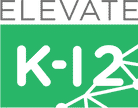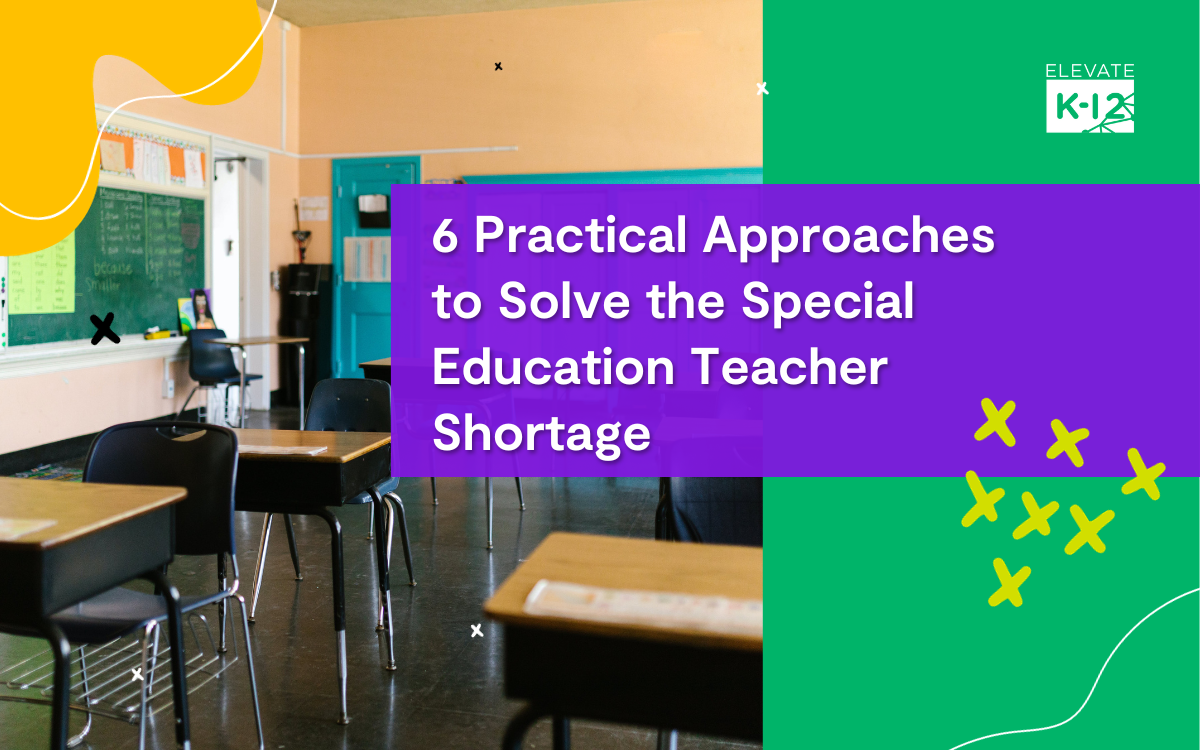School districts across America are facing a marked shortage of special education teachers, and in the post-pandemic era, the problem is getting worse, not better.
The U.S. Department of Education’s Individuals with Disabilities Education Act (IDEA) freed up funds to address the educator shortage, encouraging training and retention. Yet staffing issues persist in school systems from Virginia to California.
Numerous factors contribute to the shortage, and holistic, lasting change has been elusive for decades. While a dramatic shift won’t happen overnight, we’ve identified six practical approaches that each address an element of the problem.
Together, these six approaches can help improve the challenges of the educator shortage in special education.
6 Approaches for Tackling the Special Education Teacher Shortage
It’s time to try new approaches to address teacher shortages — especially in special education classrooms.
There’s no easy fix for a problem that’s been around for over 40 years. However, these six approaches can help school districts improve retention and address the root causes behind the special education teacher shortage.
1. Incorporating Technology and LIVE Synchronous Teaching
In a post-pandemic educational landscape, technology is playing an ever-larger role in delivering and facilitating education, including special education.
LIVE synchronous teaching is one exciting example. Synchronous remote teaching can help special education teachers and the administrators who support them in several ways:
- As a traditional resource pull-out, adding a “double-dip” of grade-level content to help meet IEP requirements
- As core instruction for students with mild to moderate disabilities who may need extra support or a slower pace of instruction
- As a way to alleviate teacher workloads (more on this in the next section)
Elevate K-12 provides certified teachers who livestream teaching directly into classrooms in real time. With certified U.S.-based special education teachers and inclusive learning managers, they can cover a wide variety of accommodations and modifications while helping schools meet the legal requirement to provide certified special education teachers.
This approach allows districts to provide quality, direct instruction for students who need exceptional attention, and gives those students a path to the education they deserve.
2. Alleviating Teacher Workloads
Unsustainable workloads are one of the primary drivers of burnout in special education. IEPs, differentiated instruction, accommodation, modifications, and reporting all matter, but whatever the time allotted to cover these needs, it never seems to be enough.
However, even amidst a teacher shortage, there are steps every district can take to lessen these caseloads.
Some districts use LIVE synchronous solutions through Elevate K-12 to relieve in-classroom teachers so they can focus on supporting inclusion, individual intervention, progress monitoring, and IEPs. With a Special Ed LIVE remote teacher handling some group instruction, the in-classroom teacher is free to handle the rest.
3. Improving In-Classroom Support
Adequate classroom support for both special education teachers and students is key. For teachers, it alleviates some of the pressure feeding this shortage, and for students, the right support enhances their ability to learn.
Elevate K-12 offers in-classroom instructors extensive support by taking some of the live instruction responsibilities off their shoulders. Our LIVE teachers can provide direct instruction to students in small groups, and in turn, in-class paraprofessionals can better support students who may need more individualized instruction or attention.
Our instructors can handle lesson planning and adaptation to accommodate various student needs. This includes planning activities to foster better student engagement and modifying assignments and assessments as needed based on individual student needs. Elevate’s certified special education teachers can even attend IEP meetings as a guest to speak to individual students’ progress and classroom participation.
With many of the live instruction duties handled by Elevate’s instructors, in-class paraprofessionals can focus on addressing immediate student needs as they arise without disrupting the flow of instruction.
4. Enhancing the Teacher’s Work Environment
An improved work environment can significantly impact special education teachers’ attrition and burnout rates. For example, allowing teachers to work remotely and set their own hours can contribute to better work-life balance and higher job satisfaction.
Elevate K-12 empowers teachers to work remotely, from anywhere in the U.S., on the schedule that works best for them. This gives teachers more opportunities to continue doing what they love in the environments they want to be in.
5. Removing Geographic Constraints from Hiring
Geographic limitations also contribute to the teacher shortage problem. Many rural and low-income districts — and even entire states — struggle to compete with districts in prime locations when enticing qualified teachers.
However, when teachers can teach from anywhere, as long as they meet the district’s state certification requirements, it eliminates this zip code problem. Elevate K-12 removes these geographical barriers, remotely connecting certified special education teachers with the districts that need them.
6. Increasing Special Education Teacher Salaries
Competitive salaries are another invaluable tool for attracting and retaining qualified special education teachers. Most special ed teachers earn the same as their general education counterparts, despite the increased day-to-day demands and higher levels of education and certification.
In generally hard-to-staff positions, higher pay and bonuses can improve recruitment and retention. And while, as the Hawaii study showed, increased compensation alone won’t solve the teacher shortage, it’s almost certainly a part of the answer.
Why Is There a Special Education Teacher Shortage?
Attrition and retention in special education are not new problems — these have been frequent topics in academic and research circles since at least the 1980s.
Current research indicates that 65% of schools are understaffed in special education. Unfortunately, despite decades of effort, the core reasons for the current shortage look similar to those of past years.
Attrition and Burnout
Attrition and burnout both weigh heavily on the special education teaching profession.
One 2020 survey revealed that 38% of special education teachers met the clinical criteria for major depressive disorder. The same percentage did so for generalized anxiety disorder. These rates are far higher than the general population’s (even adjusting for Covid-era numbers).
As a result, special education teachers are 2.5 times more likely to leave the field than other educators, and up to half of new hires leave the field within five years.
Lack of Certified Teachers
There’s also an acute shortage of teachers with the necessary certifications and qualifications to work in special education.
Federal law says that special education teachers must obtain full state certification in that field and pass the state licensing test for special education teachers. These credential requirements may deter potential candidates from pursuing a special education career due to the complexity and the time required.
Extensive Responsibilities Without Proper Support
Further, special education teachers must fulfill extensive responsibilities in their field — often with limited resources and under challenging working conditions.
Individualized Education Plans (IEPs), diverse student needs, and differentiated instruction all provide value to students. However, teachers cannot cater to these accommodations without adequate resources and support.
Increased Need and Higher Demand
We’ve already seen that there are too few teachers, too many responsibilities for those teachers, and too many teachers leaving the field.
To add insult to injury, there are also more students than ever. About 15% of U.S. public school students now qualify for special education or an IEP, a number that’s doubled since the 1980s.
How States Are Addressing the Special Education Teacher Shortage
While there is no national plan for addressing this shortage, several U.S. states have pioneered their own programs or used other methods to help address the deficit.
Alternative Pathways and Apprenticeships
Indiana’s licensing assistance program is one approach to solving the teacher shortage. Under this program:
- Licensed teachers can access a no-cost 18-credit-hour graduate program at one of three Indiana universities.
- Those currently enrolled in a special education prep program can earn scholarship assistance.
- Those with non-education bachelor’s degrees already working in special education (paraprofessionals) can enroll in a Transition to Teaching preparation program at no cost.
- Those who have completed a program but have not passed state licensure may join a free prep workshop.
Indiana’s program helps address the problem’s pipeline side, inviting more people to become licensed new teachers. But it doesn’t address burnout, attrition, or the lack of support — making it, at best, a partial solution.
Financial Incentives
Financial incentives are another approach, one that the state of Hawaii tried starting in the fall of 2020. Under the program, all special education teachers in the state received a $10,000 salary increase, with additional tiered bonuses for those in “historically hard-to-staff schools.”
The incentive made a difference in vacancies during the school year:
- Vacant special education teaching positions dropped by 1.2%.
- Combined vacant positions and those filled by unlicensed teachers decreased by 4%.
However, attrition rates remained even, as the new growth was mostly general education teachers moving into special education. So, the direct financial incentive approach solved some immediate short-term problems in Hawaii, but didn’t address the underlying causes of attrition.
In other words, another $10,000 a year wasn’t enough to keep burnt-out teachers in their classrooms.
Discover How Elevate Is Revolutionizing Special Education
The special education teacher shortage is an ongoing and urgent challenge, but lasting change is multi-faceted. That’s why Elevate is working to combat the special education teacher shortage with an innovative, technology-forward solution for live, synchronous teaching in special education classrooms that transcends geographical constraints.
Elevate’s Special Ed LIVE program reduces the load on in-classroom teachers and paraprofessionals, giving them more bandwidth for personalized instruction, IEPs, and more. With Special Ed LIVE, your district can ensure students with educational disabilities receive the remarkable teaching they deserve.
See the difference Elevate K-12 is making in special education: Explore Special Ed LIVE now.

